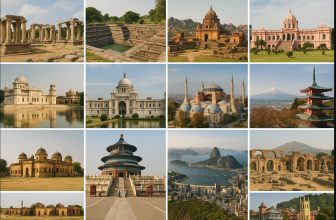Long before air conditioners, concrete, and CAD software, Indian architects designed buildings that were naturally cool, energy-efficient, and deeply in tune with their surroundings. Whether it was a haveli in Rajasthan or a temple in Tamil Nadu, ancient Indian structures prioritized function, climate, and community living. Many of these design ideas remain relevant today and continue to influence modern architecture across India.
Discover 12 timeless architectural ideas from ancient India that continue to inspire modern Indian homes and buildings with sustainability, climate-responsiveness, and design wisdom.
1. Courtyards (Chowk or Angan)
Traditional Indian homes often centered around a courtyard, especially in hot and dry regions. This open-air space allowed sunlight to enter while creating a natural flow of air that cooled the house. It also served as a gathering space for families. Today, internal courtyards are used in modern homes, schools, and offices to improve ventilation, daylight, and spatial comfort.
2. Jaalis (Stone or Lattice Screens)
Jaalis are decorative stone or wooden screens that filtered light and let in air while maintaining privacy. They reduced glare and heat, creating a cooling effect indoors. Found in Mughal palaces and Rajput forts, jaalis are now reinterpreted with concrete, metal, and terracotta in modern facades and partitions.
3. Stepwells (Baolis or Vavs)
Stepwells were both architectural and hydrological marvels—used to store water, access groundwater, and serve as social gathering points. Their tiered design adapted to changing water levels. Today, their concept informs rainwater harvesting systems and community-based water conservation structures in urban planning.
4. Verandahs and Semi-Open Spaces
Verandahs acted as shaded buffers that protected the house from direct sunlight while allowing breeze to pass through. These spaces were often used for relaxation, cooking, or informal meetings. Modern bungalows, urban balconies, and shaded terraces continue this idea to create thermal comfort and outdoor connections.
5. Use of Local Materials
Ancient builders always worked with materials available in their region—granite in the south, sandstone in the north, bamboo in the northeast. These materials were climate-appropriate, cost-effective, and culturally rooted. Modern sustainable architecture is now rediscovering the value of building with local stone, mud, brick, and wood.
6. Rainwater Harvesting
Many historic temples and palaces had hidden systems of channels, tanks, and slopes to collect rainwater and recharge the ground. These systems worked efficiently without any pumps or filters. Today, rainwater harvesting is a key feature of eco-friendly homes and has become mandatory in many Indian cities.
7. Wind Towers and Passive Ventilation
In hot regions like Rajasthan and Gujarat, structures often featured vertical shafts or wind catchers that directed cool air into rooms. This early form of passive cooling minimized heat without electricity. The concept is now used in energy-efficient buildings through solar chimneys and ventilation ducts.
8. Lime Plaster and Terracotta Finishes
Instead of chemical paints, ancient homes used lime plaster, mud coating, and terracotta tiles. These materials allowed the walls to breathe, regulated humidity, and kept interiors naturally cool. Lime finishes are now returning in eco-conscious homes for their durability and non-toxic qualities.
9. Geometrical Planning and Symmetry
Ancient Indian temples, especially those built using Vastu Shastra or sacred geometry, followed strict principles of symmetry, direction, and proportion. These ensured balance, energy flow, and aesthetic appeal. Today, similar geometrical planning is used in civic buildings, townships, and spiritual centers.
10. Multi-Use Courtyards in Mansions and Havelis
In traditional mansions, central courtyards were not just for air and light—they hosted rituals, drying food, collecting rain, or even holding livestock. This efficient use of space is echoed in modern multi-functional living areas, inner atriums, and open-plan layouts in urban homes.
11. Thick Walls for Insulation
Walls in ancient Indian homes were often made of thick stone or mud-brick, providing thermal insulation that kept interiors cool during summer and warm during winter. Today, similar effects are recreated using insulated bricks, rammed earth walls, or cavity wall systems in climate-sensitive construction.
12. Orientation Based on the Sun’s Path
Traditional buildings were carefully aligned to make the most of natural light and heat. For instance, kitchens faced east to catch the morning sun, while bedrooms were placed in the southwest for evening coolness. Modern sustainable design still follows solar orientation to reduce artificial lighting and heating needs.
Conclusion – Practical Indian Design Ideas Still Relevant in Modern Living
Ancient Indian architecture wasn’t just about beauty or symbolism—it was a masterclass in sustainable design, crafted over centuries of trial, observation, and local wisdom. These 12 design principles continue to shape modern architecture across India because they work. Whether you’re planning a home, redesigning a space, or just looking for smart ideas, turning to the past might just be the smartest move forward.





